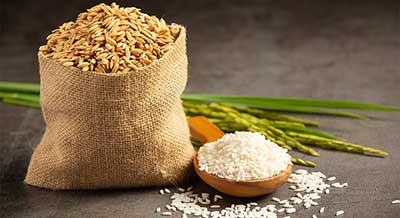Relevance: GS-3: Public Distribution System- objectives, functioning, limitations, revamping, Food processing and related industries in India- scope’ and significance, location, upstream and downstream requirements, supply chain management.
Key Phrases: Food Safety and Standards Authority of India, Food and Public Distribution, FRK, anaemic, folic acid, sustainable solutions, stunted.
Why in News?
- The Union Cabinet recently approved a scheme to distribute fortified rice under government programmes.
What is Rice Fortification?
- The Food Safety and Standards Authority of India (FSSAI) defines fortification as “deliberately increasing the content of essential micronutrients in a food so as to improve the nutritional quality of food and to provide public health benefit with minimal risk to health”.
- Various technologies are available to add micronutrients to regular rice, such as coating, dusting, and ‘extrusion’.
- Extrusion involves the production of fortified rice kernels (FRKs) from a mixture using an ‘extruder’ machine. It is considered to be the best technology for India.
- The fortified rice kernels are blended with regular rice to produce fortified rice.
How does the extrusion technology to produce FRK(fortified rice kernels) work?
- Dry rice flour is mixed with a premix of micronutrients, and water is added to this mixture.
- The mixture is passed through a twin-screw extruder with heating zones, which produces kernels similar in shape and size to rice.
- These kernels are dried, cooled, and packaged for use. FRK has a shelf life of at least 12 months.
- As per guidelines issued by the Ministry of Consumer Affairs, Food and Public Distribution, the shape and size of the fortified rice kernel should “resemble the normal milled rice as closely as possible”. According to the guidelines, the length and breadth of the grain should be 5 mm and 2.2 mm respectively.

Benefits of Fortified Rice
- Reduce higher Level of Malnutrition
- India has very high levels of malnutrition among women and children.
- According to the Food Ministry, every second woman in the country is anaemic and every third child is stunted.
- Suitable Method
- Fortification of food is considered to be one of the most suitable methods to combat malnutrition.
- Ease of Use
- This is one of the biggest benefits. As a widely used staple food, it is simple to replace standard rice with fortified rice to boost the nutritional profile of a simple diet.
- Per capita rice consumption in India is 6.8 kg per month. Therefore, fortifying rice with micronutrients is an option to supplement the diet of the poor.
- Consistency for consumers
- It looks, cooks, and tastes the same as non-fortified rice. This is great for individuals in low income countries, where awareness and education on both nutrition and usage of fortified rice may be lacking.
- Cost Effective
- The specific costs of fortified rice depend on several factors, such as the scale of the operation and the blending ratio of fortified to non-fortified kernels - most commonly 0.5-2%. However, rice fortification costs are small compared to the wide-reaching benefits.

Standards for Fortification
- Under the Ministry’s guidelines, 10 g of FRK must be blended with 1 kg of regular rice.
- According to FSSAI norms, 1 kg of fortified rice will contain the following: iron (28 mg-42.5 mg), folic acid (75-125 microgram), and vitamin B-12 (0.75-1.25 microgram).
- Rice may also be fortified with zinc (10 mg-15 mg), vitamin A (500-750 microgram RE), vitamin B-1 (1 mg-1.5 mg), vitamin B-2 (1.25 mg-1.75 mg), vitamin B-3 (12.5 mg-20 mg) and vitamin B-6 (1.5 mg-2.5 mg) per kg.
Does fortified rice have to be cooked differently?
- The cooking of fortified rice does not require any special procedure.
- The rice needs to be cleaned and washed in the normal way before cooking.
- After cooking, fortified rice retains the same physical properties and micronutrient levels as it had before cooking.
What is India’s capacity for fortification?
- Nearly 2,700 rice mills had installed blending units for production of fortified rice, and India’s blending capacity stood at 13.67 lakh tonnes in 14 key states, according to figures provided by the Ministry.
- FRK production had increased rapidly from 7,250 tonnes to 60,000 tonnes within 2 years.
- The cost of upgrading an existing rice mill varies in accordance with the volume of fortified rice produced.
- An investment of Rs 15-20 lakh would be required to upgrade a rice mill of operating capacity 4-5 tonnes/hour.
- The Ministry had estimated that the cost of producing FRK with iron, folic acid, and vitamin B-12 would be around Rs 0.60 per kg.
Note:-
- Fortified rice will be packed in jute bags with the logo (‘+F’) and the line “Fortified with Iron, Folic Acid, and Vitamin B12”.
Conclusion
- We need gentler, safer, long-term and sustainable solutions, that involve the community, and stimulate diet diversification, especially with simultaneously ongoing initiatives to increase iron intakes.
- Rice is the most common food in Indian diet but unfortunately, it contains very little nutrition and doesn’t meet the daily nutritional requirement of body. In such scenario fortified rice kernel can be a game changer.
Sources: Indian Express
Mains Question:
Q. What is fortified rice? How it is going to help India in solving its problem of malnutrition? (250 Words).









